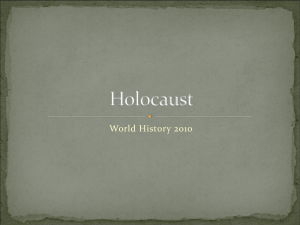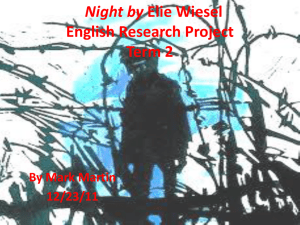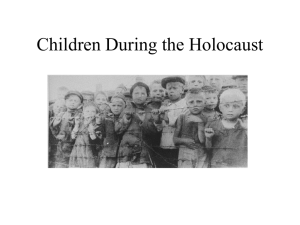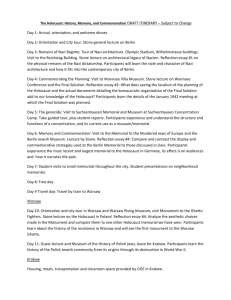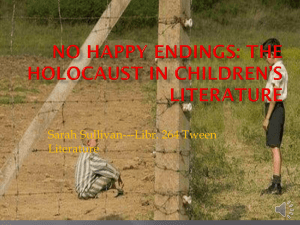Lesson Plan - Grade 8 - Bainbridge Island School District
advertisement
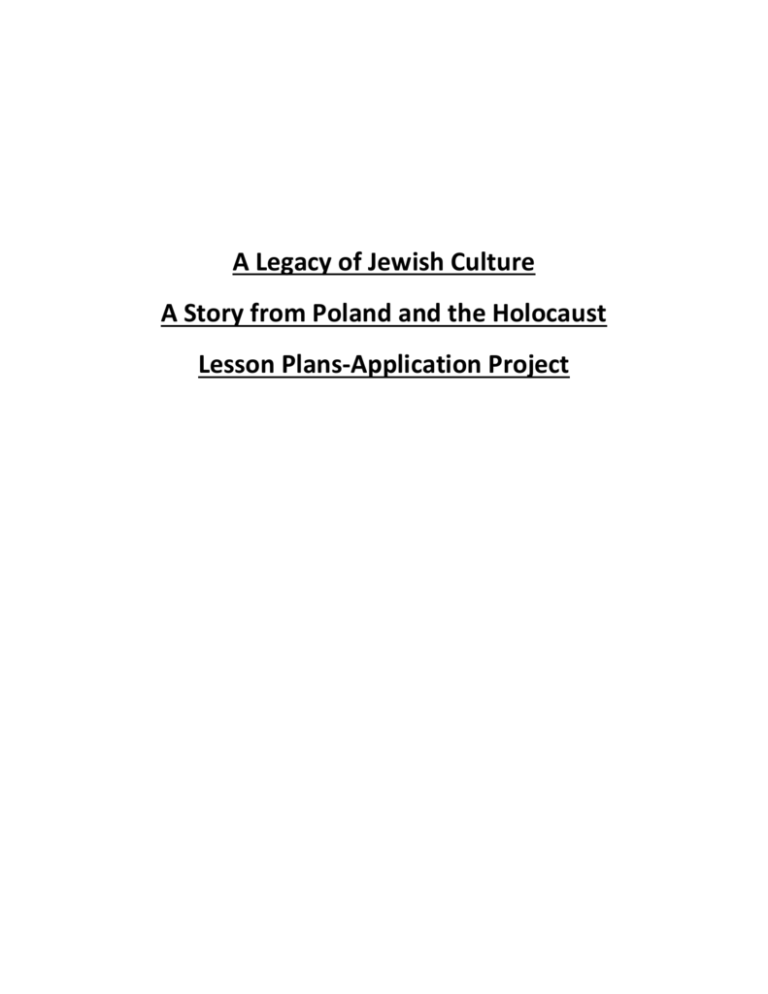
A Legacy of Jewish Culture A Story from Poland and the Holocaust Lesson Plans-Application Project Family and Consumer Sciences – Grade Eight My Media Project—Stereotypes Writing Assignment / Labeled Illustration “A Tragic Act of Prejudice / A Precious Act of Love” 1) Overview a. Topic: Storytelling/Pre-Holocaust Education b. Grade Level: Grade 8 c. General Goals, Major Concepts, Values and Skills 2) Daily Lesson Plans a. Objective Students will learn more about their own family stories, the power of tradition through family history, how to express themselves through writing, and gain a greater appreciation of understanding, tolerance, and understanding groups of diverse people. b. Activities/Procedures Introduction Overview After an introduction to the Warsaw, Poland art installment called, “I Can Still See Their Faces” and listening to read aloud/read along stories, YouTube clips, and bits of feature length film clips, all in regard to teenagers and the Holocaust which took place in Poland 1939-1945, students will reflect upon and write a short, of a selected face in the exhibit. After completion of this story, students will author a story from the recent or distant history of their own family. The title of the personal, second story will be either, “A Tragic Act of Prejudice” or “A Precious Act of Love”. They will attach a photograph or alternative illustration of the people in the story they prepare. Sharing the story with our class is optional. Students may choose to write and illustrate a second story. This assignment may seem far too personal for a group of 14 year old students, but it follows a three week intensive unit involving Family and Friends, thus I can guarantee the emotional safety boundaries are in place, and they are ready for this jump in affective education. Day Number 1 Students will be told they are going to witness a number of different styles and content areas of family stories. Soon they will be asked to think of and tell a story from their recent family history, or a story passed down through generations within their family. They will also know the story will be about tragity or love, or both. Storytelling by Ellen Schiff, trained storyteller from Indianola, WA: Ellen will share stories about family relationships, all involving resolved hardship, and/or lessons or morals. Ellen will lead a class discussion in order to process and reflect upon her stories. Day Number 2 Using a number of reading methods, parts of books about teens and the Nazi Holocaust in Poland will be presented. These stories from books will be chosen carefully to reflect the age and maturity of a fourteen year old child. A wide variety of pictorial, multimedia depictions of these stories will also be shared with students. Methods include: Silent Reading, Reading Aloud, groups of four acting out plot for another group, round robin, selected pieces shared with a partner, etc. Day Number 3 Three to six minute long clips from YouTube, films, videos, TV, or feature length films will show parts of stories. This activity will last about 25 minutes. Students will choose a picture from I Can Still See Their Faces (see photographs), writing a 15 minute free write about who they see in the selected picture. Day Number 4 Reflection time, with guided imagery to help determine what students may like to write about. Note taking or drawing is encouraged, but not required. Day Number 5 Rough Drafts, Student Edits, and Peer Edits allowed, but not required. Continued writing, with provided personal family pictures, or take time to draw a picture (out of class). Some students may wish to provide an old photo, new photo, or other piece of art work first. Sharing Stories aloud will be encouraged but not required. Stories are turned into the teacher. c. Student Evaluation A completed story, with a completed Illustration 4 Part Rubric for Story, 4 Part Rubric for Illustration, and 4 Part Rubric for Optional Oral Presentation. Rubric: Incomplete—Meets Expectations—Exceeds Expectation—Outstanding d. Summary of Content This short unit is a part of the larger unit on Stereotypes and Prejudice. During this time we will learn about the concept of the perpetuation of culture, through the skill of storytelling. Students will share a personal, family story involving a tragic act of prejudice or a precious act of love, or both. e. Supplemental Materials and Bibliography of Resource Books Frank, Anne and Frank, Otto M. ed. The Diary of a Young Girl: The Definitive Edition. New York: Double Day Books, 1995. ISBN: 978-0-307-80753-3 Picoult, J. The Story Teller. New York: Atria Books, February 26, 2013. ISBN: 1444766635 Tuval/Bernstein, Sara. The Seamstress. New York: Berkley Books, Putnam and Sons, October 1, 1997. ISBN: 0-425-166309 Wiesel, Elie. Night. Bantam Books: New York, New York, 1960. Yolen, Jane. Devil’s Arithmetic. New York: Puffin Books, 1998. Guest Speaker: Expert Storyteller, Ellen Schiff of Islandwood-Bainbridge Island Education Center Teacher’s films, photos, interviews, stories, and notes from Poland Individual camera, copy of family photo(s), computers, art materials. I Can Still See Their Faces is a 2011, permanent installment of art showing larger than life photographs of Jewish residents of cities of Warsaw and Krakow, Poland in the late 1930’s, just prior to the beginning of the Warsaw Ghetto. One of the surviving buildings of the era, a currently populated tenement building is the backdrop of the photographic images. Here is an explanation from the website: The Holocaust and the subsequent destruction of Warsaw in WWII erased virtually all remnants of the bustling pre-war Jewish community’s presence in the city, but there is one place where it is still possible to sense this lost age. There are two rows of dilapidated tenement houses dating from 1880-1900 on ul. Próżna (B-3) showing what Warsaw must have looked like, and adding to this is a series of giant photos hanging outside the tenement on ul. Próżna 14 that depict members of the disappeared Jewish community. These photos are there thanks to a project called ‘I ciągle widzę ich twarze’ (I Can Still See Their Faces) which was created by Gołda Tencer, a Polish actress with Jewish origins who is the founder and director of the Shalom Foundation. In 1994 she appealed to people to send in photographs of Polish Jews so that an exhibition could be created commemorating those who died. The incredible response netted over 9,000 photographs, some from survivors and their families, some from Polish neighbours or friends of those killed. Then in 2008 the ‘I can still see their faces exhibition’ was mounted in ul. Próżna as part of the commemorations of the 65th anniversary of the Ghetto Uprising. The effect is quite stunning, particularly when you consider this street was once bustling with life, full of traders, stores and Jewish families. Located in the heart of a now modern city, this really is a place worth a moment of your time, especially now that the major renovations to the street have been completed. The installation goes without explanation, but you may find more information about it at: http://www.inyourpocket.com/poland/warsaw/sightseeing/jewishwars aw/I-Can-Still-See-Their-Faces_71060v “Poland Holocaust History-What Can We Learn?” Social Studies – AP Grade Tenth Grade-Sophomore Level Holocaust Education-Kelly Wheeler Three Week Unit of Study Prior to Unit: Set-Up Journals: Students will keep journals, noting examples of hatred as well as quotes of merit that provoke thoughtfulness. In these journals, students will also respond to prompts and reflection pieces on a personal level in regard to what they read. An opening activity will take place each day with questions designed for student focus. These questions act as a prompt or aid to class discussion. Journals are to come to class each day, or students may leave journals stored in the classroom. Day Number 1: Theories of Types of Hate/Fear and Love -vs- The Pyramid of Hate The Spectrum of Hate* and the Pyramid of Hate* are circulated to students. Exploration of Terminology Definition: Name Calling Ganging Up On Scapegoating Stereotyping Discrimination Anti-Semitism Prejudice Bigotry Racism (Racial Profiling) Reconciliation Responsibility Genocide Stand Your Ground Laws Controversy Questions: What is the difference between “stereotyping” and “discrimination”? …“discrimination” and “prejudice”? Compare the Spectrum of Hate* with the Pyramid of Hate*: Which model most accurately depicts the concept of hate? Why? Look at the United Nations Definition of Genocide* Class Discussion Small Groups brainstorm in order to begin to draw their own Pyramid of Understanding, Safety, and/ or Love. Day Number 2: World War I: The Conclusion and as a Catalyst of World War II Topics Discussed: European Economy of 1800s through early 1900’s Hitler’s Platform and Promise*, Timeline Handout from Holocaust Education Resource Center Importance of Ancestral Lands Continued Work on Pyramid of Understanding, Safety, or Love Day Number 3: History of Anti-Semitism Topics Covered: Various Myths Concerning Jews* Russian Pograms Timeline of Nazi Party* from Holocaust Education Resources Center (continued from previous day) Nuremburg Laws* Day Number 4: Timeline of WWI and Hitler’s Final Solution Topics Covered: Nuremburg Laws* (continued from previous day) Teacher Generated Concentration Camps (power point, YouTube clips) Death Camp -vs.- Labor Camp -vs.- Prisoner of War Camp Definitions Explanation of different groups involved in discrimination, including Jews, Jehovah Witnesses, Homosexuals, Mentally and Physically Handicapped, Political Dissidents, Others. Day Number 5: Propaganda’s Role in the Nazi Movement Propaganda as defined in a dictionary: “Spreading of ideas, information, or rumor for the purpose of helping or injuring an institution, a cause, or a person OR ideas, facts, or allegations spread deliberately to further one’s cause or to damage an opposing cause; also a public action having such an effect…” Propaganda can be “good” or “bad”. Discuss examples of both positive and negative, and substantiate manipulation used for intent of presentation of propaganda. Focus on negative, “bad” propaganda used by Nazi Party at the time leading toward and during WW2 Europe. Find examples or incidents of propaganda* (furnished) Determine which levels of the Pyramid of Hate* are highlighted in each instance...explain how and why? What do you think was the intent or purpose of using the highlighter areas in propaganda speeches, lessons in schools, pamphlets, posters, or advertisements*? Day Number 6: The Matrix of the Individual* -vs. - The Society. What do individuals do to preserve themselves, when they encounter hate? Parts of the Matrix of the Individual*: Victim-Bystander-Perpetrator-Resistor Term Definitions: Victim a person toward whom hate acts are directed, can be an upstander or survivor Bystander a person whom stands by while hated is directed toward another, yet does little or nothing to intervene on behalf of the victim. Perpetrator a person whom commits an act of hatred Resistor a person that is willing to stand against hatred (upstander or survivor) Upstander or Survivor a person who fights against hatred when encounter in instances directed toward themselves by others. Allow students to brainstorm various situations that would fit into this matrix. Examples may include taxes, taking drugs, donations to charity, bullying at the bus stop, sharing your pencil, gossiping, etc. The students will be able to come up with many kinds of examples. Class discussion about why they placed the situations in different parts of the Matrix. Reflection questions are provided at the bottom of the page of the Matrix. Discuss a common example, or an example most students have in common. Take Treavon Martin and George Zimmerman for an example. Talk about how people can experience hate in a variety of ways, depending on a given situation. Why is this? What compels people to act in one way in any given situation, but in another way in another situation? Discuss Bullying. Recognize that depending upon a situation; a person can fit into a variety of areas of the Matrix. Days Number 7-11 People Have Faced Hatred in their Own Words: Selected parts of the book The Seamstress, by Sara Tuval Bernstein Selected parts of the book The Storyteller, by Jodi Picoult Selected part of the book Night, by Elie Wiesel Selected part of the book Man’s Search for Meaning, by Victor Frankl Facing History and Ourselves Education Website Jewish Holocaust Education Resource Center Website Warsaw (Ghetto and Auschwitz Camp) Specific: Victim: Jewish Councils-The Warsaw Ghetto, Facing History and Ourselves Victim: Warsaw Ghetto Uprising-ZOB, Facing History and Ourselves Perpetrator: Warsaw: Crimes Against Humanity* Resistor: Zygielbojm: Warsaw to Life* Resistor: The Warsaw Ghetto Uprising-Voices of Humanity, Facing History and Ourselves Bystander: A Return to the Ghetto, Facing History and Ourselves Discuss the Roles in the Matrix, as well as the Spectrum* and Pyramid of Hate* What cause were people fighting, experiencing, or perpetuating? Use examples from the texts listed above. Triblinka Concentration Camp Specific Perpetrator: Franz Stangl: Commandant of Triblinka-How is Humanity Possible?* Resistor: Resistance: Triblinka, Facing History and Ourselves Discuss the Roles in the Matrix, as well as the Spectrum* and Pyramid of Hate*. What cause were people fighting, experiencing, or perpetuating? Use examples from the texts listed above. Lublin City Specific: Bystander: Kurt Gerstein-Bystander-How is Humanity Possible?* Discuss the Roles in the Matrix, as well as the Spectrum* and Pyramid of Hate*. What cause were people fighting, experiencing, or perpetuating? Use examples from the texts listed above. Majdanic Death Camp Specific (located within the city limits of Lublin) Resistor: Survivors and Memory, Facing History and Ourselves Discuss the Roles in the Matrix, as well as the Spectrum* and Pyramid of Hate*. What cause were people fighting, experiencing, or perpetuating? Use examples from the texts listed above. Auschwitz Concentration Camp/Birkenau Death Camp Specific (located within the City of Oswiencim) Victim: Auschwitz Survivors’ Stories: Crimes Against Humanity* Victim: Auschwitz, Facing History and Ourselves Perpetrator: Rudolf Hoss: Commandant of Auschwitz-How is Humanity Possible?* Resistor: Bannet: Auschwitz: To Life* Discuss the Roles in the Matrix, as well as the Spectrum and Pyramid of Hate. What cause were people fighting, experiencing, or perpetuating? Use examples from the texts listed above. Day Number 12: Reflections and Sharing Read Aloud: The Perils of Indifference, by Elie Wiesel Timed Writing Lesson: Elie Wiezel writes, “Neutrality helps the oppressor, never the victim. Silence encourages the tormentor, never the tormented.” How is this true/untrue in your own life experience? Taking what you now about WW2 in Europe, and our readings and discussions of the holocaust, talk about what happens to the Pyramid of Hate when bystanders are added. What happens when the Role of the Resistor is added? Day Number 14 Socratic Seminar Students will read along as a video interview is read of Elie Wiesel’s “A God Who Remembers” PBS and NPR. The link to this reading can be located at: http://www.npr.org/templetes/story/story/php?storyId=89357808 Students will reflect, then write at 250+word typed essay using the “deep thought” method, on the following topic: Think about our experiences and readings. Write about Elie Wiesel’s impact on your current civilization, your current society, and your potential future. What is your responsibility as a keeper of his memories? Day Number 15 - Saturday Evening Optional Meeting: Shabbat in Our Classroom Volunteer local students, parents, members of the Jewish Community help class student volunteer students understand the meaning and traditions of a Shabbat Dinner within our school cooking classroom. Bibliography “Appendix Timeline 1933-1939” Echoes and Reflections: A Multimedia Curriculum of the Holocaust. New York, Los Angeles, Jerusalem: The AntiDefamation League, USC Shoah Foundation Institute, Yad Vashem, 2005. Choices for the 21st Century Education Program. Confronting Genocide: Never Again. Providence, RI: Watson Institute for International studies, Brown University, 2003. Crimes Against Humanity: A Holocaust Resource Book. Madison, WI: Knowledge Unlimited. 1999. Museum of Jewish Heritage. To Life: 36 Stories of Memory and Hope. Boston: Bulfinch Press, 2002. Frankl, Viktor. Man’s Search for Meaning. Beacon Press, June 1, 2006 (originally 1946). Roy, Jennifer. Yellow Star. Marshall Cavendish, 2006. Wiesel, Elie. Night. Bantam Books: New York, New York, 1960. Ofner, Terry, ed., Voices of the Holocaust. Des Moines: Perfection Learning, 2012. Schabas, William A. The Convention for Prevention and Punishment of the Crimes of Genocide: Paris, 9 December 1948. http://untreaty.un.org/cod/avl/ha/cppcg.html Strom, Margot Stern. Facing History and Ourselves: Holocaust and Human Behavior. Brookline: Facing History and Ourselves, national Foundation, Inc., 1994. Steinfeldt, Irena. How was it Humanly Possible? A Study of Perpetrators and Bystanders during the Holocaust. Jerusalem: International School for Holocaust Studies, Yad Vashem, 2002. The Universal Declaration of Human Rights http://www.un.org/en/documents/udhr/index/shtml In the December 20, 2012 edition of The New York Review of Books, Tim Snyder (Bloodlands) reviews eight books of new important scholarship, in his piece entitled: Hitler’s Logical Holocaust. http://www.nybooks.com/articles/archives/2012/dec/20/hitlers-logicalholocaust/ Emanuel Ringelblum much of what we know of Polish-Jewish life especially within the Warsaw Ghetto would be lost to us. Samuel Kassow’s book, Who Will Write Our History: Emanuel Ringelblum, The Warsaw Ghetto and the Oneg Shabes, Achieve. Preface written by Samuel Kassow. http://poetryinhell.org/ The following article from the May 24, 2013 edition of The Forward: How a 1976 Exhibit Changed the Way We Think about Jewish History http://forward.com/articles/176222/how-a--exhibit-changed-the-way-we-thinkabout/?p=all The following report, Jewish Life in Poland: Achievements, Challenges and Priorities since the Collapse of Communism, was prepared by the Institute for Jewish Policy Research (2011). I select this not only because this report is interesting, but because it triggers for me a greater question of the historical ebb and flow of minority and majority cultures. http://www.jpr.org.uk/downloads/JPR%20Poland%20report%20for%20website.p df The Forum for Dialogue Among Nations (Forum). The Forum is a non-profit Polish organization whose mission is to foster Polish-Jewish dialogue, eradicate antiSemitism and teach tolerance through education. I have provided a link to one of their most important programs (the first link) and their publication, Difficult Questions in Polish- Jewish Dialogue which is used in the schools participating in the program: School of Dialogue. The latter will be useful when we engage in discussions with Polish teachers in Lublin. http://www.dialog.org.pl/en/programs.htm http://www.difficultquestions.org/ The following link is to a paper entitled: The Holocaust-Coming to Terms with the Past in Post- Communist Poland by Jolanta Ambrosewicz-Jacobs. The paper was presented in 2012 at the United States Holocaust Memorial Museum’s Center for Advanced Holocaust Studies. Ambrosewicz-Jacobs is the Director of the Center for Holocaust Studies at the Jagiellonian University in Krakow. http://www.ushmm.org/research/center/publications/occasional/201212/paper.pdf * Student Handouts and Examples found on Internet, Jewish Holocaust Education Resource Center http://www.wsherc.org/center/main_page.aspx


